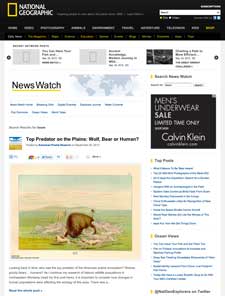Dedicated to advancing scholarly and public understanding of the past, present, and future of western North America, the Center supports research, teaching, and reporting about western land and life in the United States, Canada, and Mexico.
Announcing the Thomas D. Dee II Graduate Dissertation Fellowship in the American West

The first-ever Thomas D. Dee II Fellowship will go to Kathryne Young
Thomas D. Dee II, Stanford Class of 1941, had two passions: the American West and Stanford University. The Bill Lane Center for the American West is proud to announce a new fellowship in Dee's honor, the Thomas D. Dee II Graduate Dissertation Fellowship in the American West.
Dee arrived at Stanford in 1937. After growing up in the relatively small town of Ogden, Utah, he had the opportunity at Stanford to meet people from all over the country. Like any first-year student, Dee struggled with homesickness, but he also enjoyed the new exposure to Stanford's community of learning and to broader, national issues. Dee became a Social Sciences major, and he served in leadership roles in Varsity Baseball, the Stanford Glee Club, Scabbard and Blade, and Phi Kappa Sigma fraternity. His son David described Stanford as an eye-opening, life-changing experience: "You know, my Dad, he had a few passions in the world. One of them was certainly Stanford."
The grandson of pioneers, Dee had a deep commitment to the American West. Thomas' grandparents, Thomas Duncombe Dee I and Annie Taylor Dee, settled in Ogden as part of the nineteenth-century Mormon migration to Utah. With the completion of the Transcontinental Railroad in 1869, Ogden became an increasingly important city. Over the years, the Dee family played an important role in Utah's civic and business affairs, including the Utah International Construction and Mining Company.
Dee's sons, David and Thomas, set up the Dee fellowship as a way to honor their father's memory and to further his engagement with Stanford and the West.
As Stanford begins the 2012-13 academic year, the Bill Lane Center for the American West welcomes the first-ever Thomas D. Dee II Graduate Dissertation Fellow, Kathryne Young. Young is a Ph.D. candidate in sociology and also holds B.A. and J.D. degrees from Stanford. Her research focuses on questions of law, gender, and race. She will complete her dissertation during her year at the Center and plans to receive the Ph.D. in June 2013.
Center's "Mapping Texts" Project Presented in Digital Scholarship Journal
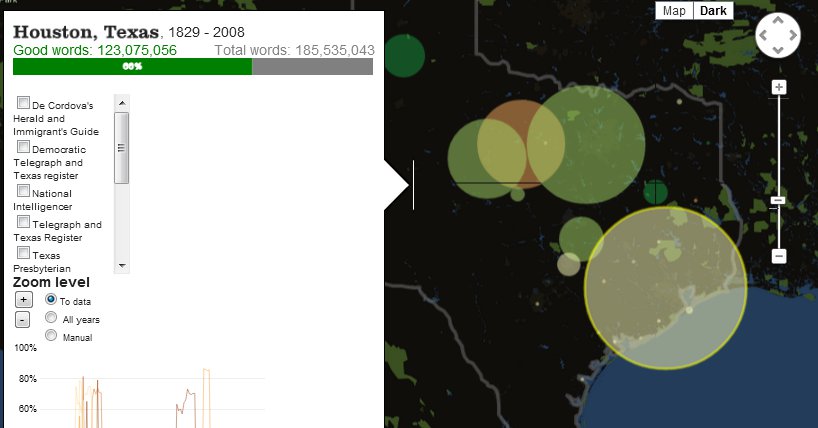
Detail from a visualization produced for the Mapping Texts project
Mapping Texts, the Center's recent collaboration with the University of North Texas, is one of several Stanford projects showcased in the current Journal of Digital Humanities, published today. In the article "Building New Windows into Digitized Newspapers," co-authors Jon Christensen and Andrew Torget describe the exciting opportunity and daunting challenge faced by scholars dealing with historical documents like newspapers that have been optically converted into digital texts.
In building Mapping Texts we wanted to create more transparent windows into the extraordinary wealth of information available in online archives of digitized historical newspapers. We wanted, for example, to be able to see how much information was available for any particular time and place, and then measure just how much of that information was still recognizable – and thus useable – after the digitization process. We also wanted to be able to see the major language patterns coming from these datasets, so that we could use “distant” readings of such massive collections as a way to determine which individual newspapers would likely yield the most useful information from “close” readings. We wanted, in other words, more finely grained methods for indexing both the quantity and quality of information in these archives as they spread out across both time and space.
The authors go on to describe the process that led to two interactive visualizations of the University of North Texas' online archive of 232,500 pages: one that allows scholars to assess the optical conversion quality of the collection – where and when are the most reliably readable documents?; the other presenting the results of several natural language processing tools that were used to machine-read the collection.
The journal includes a review of Mapping Texts by the American Studies scholar Robert Nelson, as well as contributions by the Stanford scholars and technologists Matthew Booker on mapping the history of San Francisco Bay, and Elijah Meeks and Karl Grossner on their interactive digital model of the Roman world.
Fighting the Good Fight
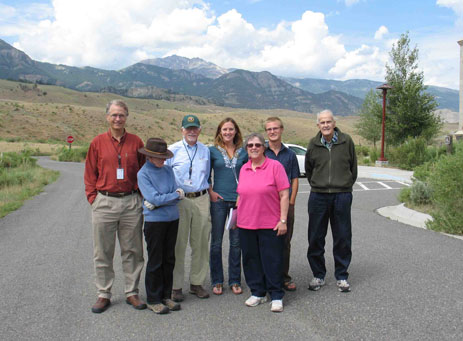
B.A. in Biology, 2013
Summer Intern at Yellowstone National Park
Read about our summer research projects on the OutWest student blog. Throughout the summer, the Center's interns and Research Assistants will be sending in virtual postcards, snapshots and reports on their summer work.
 I started the summer with next to no knowledge about North American lithic technology, plains archaeology, Yellowstone National Park, or cultural resources management. Now, I can identify and date diagnostic projectile points up to 10,500 years old, hold an intelligent conversation about prehistoric plains chronology, navigate my way through a bison jam, and appreciate the subtler points of Section 106 and Section 104 mandates. It’s hard to imagine that I’ve already been here for three months, and that it’s now time to leave. I feel like I could spend the rest of my life in Yellowstone and just begin to scratch the surface.
I started the summer with next to no knowledge about North American lithic technology, plains archaeology, Yellowstone National Park, or cultural resources management. Now, I can identify and date diagnostic projectile points up to 10,500 years old, hold an intelligent conversation about prehistoric plains chronology, navigate my way through a bison jam, and appreciate the subtler points of Section 106 and Section 104 mandates. It’s hard to imagine that I’ve already been here for three months, and that it’s now time to leave. I feel like I could spend the rest of my life in Yellowstone and just begin to scratch the surface.
The mountain of work bequeathed to the archaeologists in Yellowstone is enormous. Most of the work comes in the form of compliance requests – every federal project that could feasibly affect cultural resources in the park needs to be approved by the park archaeologist. In a place as culturally rich as Yellowstone, the projects seeking approval pile up quickly. Additionally, there are boxes upon boxes of backlogged ‘problem artifacts’—remnants from bygone contracted archaeologists who never finished analyzing and cataloging their finds (or in some cases cataloged them incorrectly, which presents a host of new problems). A single person could occupy themselves for years trying to sort through the thousands of backlogged artifacts and projects. The job descriptions of Staffan and Robin, the park archaeologists, could read like war plans – defeat the compliance requests, conquer the mess of incomplete reports, do battle with the backlog.
Reflections on the Center's Media Collaborations
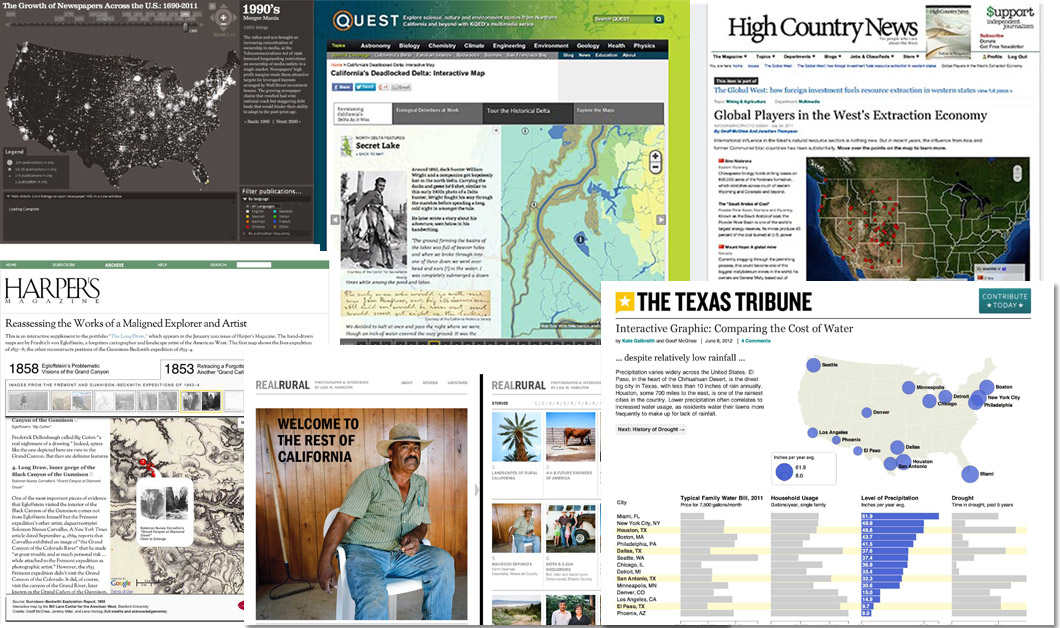
Over the past year, our western media fellowships have increasingly focused on collaborative projects among journalists, researchers, scholars and technologists. Together with such partners as KQED Public Media, The Texas Tribune, Harper's Magazine, and High Country News, we've published a number of interactive maps and data visualizations on contemporary and historical western subjects, from water and ecosystems to rural communities and economic development, from the growth of western media to forgotten explorers.
We're proud to have a post describing these projects — as well as our work at the Rural West Initiative — on the innovation-tracking site PBS Mediashift:
In our small lab at Stanford University, we've been prototyping new models of collaboration that bring journalists together with university researchers and scholars. We're eager to share them because we hope that others will take them up, use them, and improve upon them. We believe journalists and scholars and researchers can -- and should -- be natural collaborators. And in our rapidly changing media landscape, we need each other more than ever.
We hope you'll take a moment to read the post, browse through some of our projects, and share your thoughts.
"Stop Saving the Planet!" Jenny Price's Plea for a More Just and Thoughtful Environmentalism
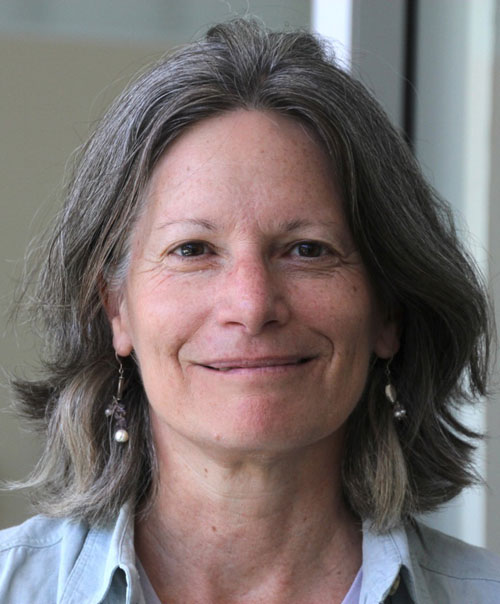
Jenny Price is a visiting scholar at the Bill Lane Center for the American West. On Monday, October 1, she will present some of her recent thoughts and writings at a special public event presented by Stanford's Environmental Humanities Project. Among her latest set of essays: a revisionist paper about Rachel Carson, and "Green Me Up JJ," a satirical advice column written in the spirit of "The Daily Show." As a writer, Los Angeles Urban Ranger, and research scholar at UCLA, Price says that she has become dismayed by contemporary environmentalism, which she says promises conservation through consumption, and whose benefits are inequitably shared:
It emphasizes changing your light bulbs versus transforming the national energy grid. It focuses on buying nontoxic paints and carpets versus banning toxic paints and carpets. Not that individual action can’t be important—but there’s a lopsided faith in its effectiveness, and in personal versus more collective kinds of virtue. While you see the “50 simple things (or 10 things, or 24 things) you can do to save the earth (or the planet)” lists all the time, none of them ever says, Vote!, or Pay your taxes!, or Stop fudging your deductions, for goodness sake!--which would likely be a lot more effective than changing your light bulbs--much less, Hold Apple accountable! Or, Buy low-VOC paint for the people who work for you! Or, especially, Pay more to the people who clean and paint your houses, so that they can buy low-VOC paint!
– From Jenny Price's essay, Stop Saving the Planet!—and Other Tips via Rachel Carson for 21st-Century Environmentalists
Price, the author of Flight Maps: Adventures with Nature in Modern America and "Thirteen Ways of Seeing Nature in L.A.," has taught at UCLA, USC, and Antioch-Los Angeles, and she and was the fall 2011 Anschutz Distinguished Fellow in American Studies at Princeton University.
The event is free and open to the public, and will take place from 6 to 8:30pm on October 1 in the Terrace Room of Margaret Jacks Hall on the Stanford campus. Attendees are encouraged to read Price's essay and articles beforehand.
Center Summer Intern Considers Human Effect on the Plains
Through the Center's internship program, Michelle Berry spent her summer at the American Prairie Reserve, a Montana-based nonprofit that acquires and manages land trusts in the West. Her research on the historical wildlife populations in northeastern Montana was featured in The National Geographic Society's NewsWatch blog.
Berry writes:
"Looking back in time, who was the top predator of the American prairie ecosystem? Wolves, grizzly bears… humans? As I continue my research of historic wildlife populations in northeastern Montana, it is important to consider how changes in human populations were affecting the ecology of this area. There was a tendency among European and American explorers to romanticize the landscapes they encountered as pristine paradises flourishing with wild animals and vegetation. In fact, this land had been inhabited by hundreds of thousands of humans that had shaped the ecosystem in variable ways."
New Study Reconstructs the Historical Sacramento-San Joaquin Delta
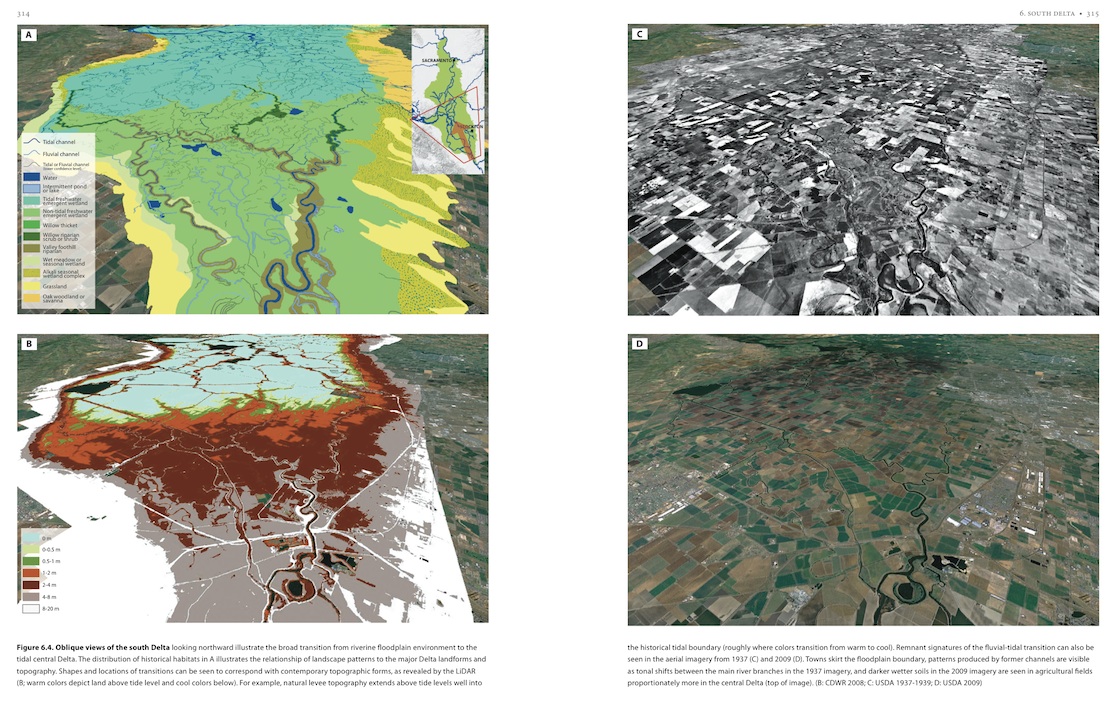
Page layout from the historical ecology study (Source: San Francisco Estuary Institute Aquatic Science Center)
The California Department of Fish and Game has released a landmark historical ecology report on the Sacramento-San Joaquin Delta, looking at how it "has been transformed over 150 years from the largest system of wetlands on the West Coast of the United States into an expanse of farms, levees and channels that support California’s water delivery system."
The report, compiled for the state over several years by the San Francisco Estuary Institute – Aquatic Science Center, is intended to help guide efforts to improve the Delta's ecological function by creating a snapshot of how its natural systems once functioned. According to SFEI-ASC's Senior Scientist Robin Grossinger, the purpose of the study was, “not to go back, but to understand how this landscape worked so we can re-establish ecologically functional and cost-effective habitats within the contemporary landscape,”
The report – and the research behind it – were the basis of an interactive feature co-produced by the Center, SFEI, and KQED Public Media's science and the environment program QUEST.
The full report is available for download from the San Francisco Estuary Institute's website, or for ordering in hard copy.
Read more at the California Department of Fish and Game website »
Kathy Zonana Joins the Center as Associate Director

Kathy Zonana, the Center's new Associate Director, with Jon Christensen
The Bill Lane Center for the American West is pleased to welcome Kathy Zonana, who joins us as Associate Director. She succeeds Jon Christensen as the administrative head of the Center and its programs.
Zonana brings a wealth of experience to the Center, from law to journalism to academic administration. Most recently, she managed special projects for Stanford's Office of Business Affairs, working with the university's Assistant Vice President for Business Development and University Privacy Officer. Before that, she spent 13 years at the university's award-winning alumni magazine, serving as Managing Editor and Senior Web Content Editor. She is an active member of the community, working with local charities and social service organizations, including the Bay Area Outreach and Recreation Program. Zonana is also a two-time graduate of Stanford University, holding a J.D. from Stanford Law School and a B.A. in American Studies.
"Kathy Zonana is a woman of the West," said the Center's faculty director, David M. Kennedy, "and she brings to the Bill Lane Center a native westerner's passion, savvy, and creativity, as well as a wealth of experience at Stanford. She will contribute powerfully to advancing the Center's mission."
"I'm delighted to leave the Center in the able hands of Kathy Zonana and the rest of our tremendously talented and dedicated staff," said Jon Christensen, the Center's executive director. Zonana takes the reins from Christensen, who is moving to the University of California, Los Angeles, this fall, where he will take up a joint appointment in the History Department and the Institute of the Environment and Sustainability. "The Center is thriving now and in a terrific position to continue making an enduring contribution to Stanford and the West," Christensen said. "I look forward to watching what comes."
Please join us in welcoming Kathy Zonana to the Center, and feel free to stop by and say "howdy!" She will begin working at the Center on Tuesday, September 4.
Center Researcher Contributes to Major Report on Climate Change in California
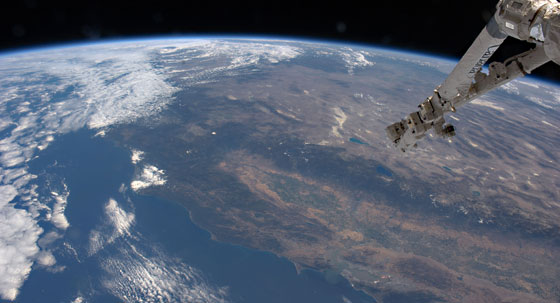
Photograph: Fragile Oasis via Flickr
This summer, the California Energy Commission published a major report assessing the state's vulnerability to climate change. The report looked at threats to infrastructure and human health, the effects of climate change on agriculture, water resources and wildfires, and sought to identify the most vulnerable ecosystems in the state.
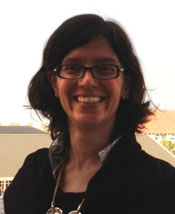
Maria Santos is an ecologist and postdoctoral scholar at the Bill Lane Center for the American West.
The culmination of 18 months of work, the report brought together contributions from over 120 researchers, among them the Center's postdoctoral scholar, Maria J. Santos, who co-authored the paper "Identifying Vulnerable Species and Adaptation Strategies in the Southern Sierra of California Using Historical Resurveys."
Santos and her colleagues focused on a transect of the southern Sierra Nevadas that includes Yosemite National Park, an area whose flora and fauna had been extensively surveyed in the early to mid 20th century. By comparing present-day observations with the historic data, the team was able to see how small mammals changed their ranges over the last century. Moreover, because the Yosemite transect contains both developed and protected areas, the team was able to gauge the effect of human actions as well.
The study found that species at high altitudes reacted differently to direct and indirect effects of climate change than did those at mid and low elevations. While their most suitable habitats tended to move to lower elevations, the animals themselves tended to move to higher altitudes in response to changing conditions, suggesting that the adaptive capacity of a number of species to climate change may be limited.
Santos says that the wealth of evidence provided by the historical resurvey will make it possible to develop better models for how future climate change could impact habitats and the species that depend on them.
The complete report is available from the California Energy Commission.
Read the report by Maria J. Santos, Craig Moritz and James Thorne »


